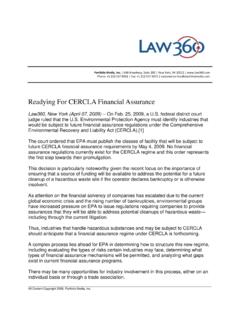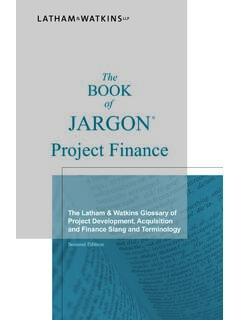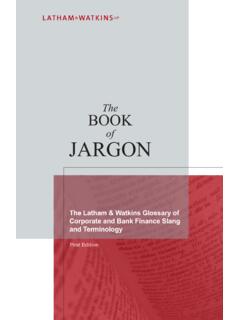Transcription of SAB 99: The SEC Defines “Materiality” - Latham & Watkins
1 SAB 99 simportanceextends beyondthe realm offinancialstatements andcould beapplicable to all materiality THE Latham & Watkins CORPORATE DEPARTMENTBULLETIN NO. 101 DECEMBER 29, 1999101 SAB 99: The SEC Defines materiality On August 12, the staff of the Securities andExchange Commission released staff Ac- counting bulletin No. 99 (SAB 99) to addressthe use of materiality thresholds in thepreparation and audit of financial state-ments. SAB 99 is styled as a summary of thepractices currently followed by the staff atthe Office of the Chief Accountant and theDivision of Corporation Finance in adminis-tering the disclosure requirements of the fed-eral securities laws. However, SAB 99 simportance extends beyond financial state-ments and could be applicable to all mate-riality determinations. As such, it is mustreading for all securities lawyers and otherparticipants in the preparation of disclosuredocuments for use in the capital 99 was issued in response to two per-ceived staff concerns: 1) the increasing prac-tice by registrants and their auditors of usingquantitative thresholds as rules of thumb inassessing materiality when preparing finan-cial statements; and 2) the increasing prac-tice of some registrants to attempt to manage reported earnings through whatthey consider to be immaterial audit adjust-ments to financial statements.
2 Part One ofSAB 99 states that sole reliance on numeri-cal or quantitative thresholds in determiningthe materiality of a specific item is insuffi-cient. If SAB 99 had gone no further, therewould have been little controversy. Instead,it proposes a methodology for materialityanalysis. While registrants and auditors maylook to quantitative thresholds as an initialstep in determining the materiality of a par-ticular item, qualitative factors must alsobe considered. In addition, accountants mustgive weight to the context in which a user ofthe financial statements would view theitem. SAB 99 purports to reiterate extantconcepts of materiality expressed in federalcase law and accounting literature to supportthe proposed analytical Case LawWhile both the rules under the Securities Actof 1933 and the Exchange Act of 1934 uti-lize the concept of materiality , its meaninghas been fully addressed by case law.
3 In TSCI ndustries, Inc. v. Northway, Inc., 426 (1976), the Supreme Court of the Unit-ed States articulated the standard of materi-ality under the proxy rules. The Court heldthat a fact is material if there is a substantial likelihoodthat a reasonable shareholder wouldconsider it Put anotherway, there must be a substantial like-lihood that the disclosure of the omit-ted fact would have been viewed bythe reasonable investor as havingBULLETIN NO. 101 DECEMBER 29, 19992 CLIENT ALERT significantly altered the total mix of informa-tion made available. Northway, 426 at Northway, courts applied this standard ofmateriality in contexts other than proxy Basic Inc. v. Levinson, 485 224 (1988), theSupreme Court adopted the Northway standard inthe context of Rule 10b-5. The Basic Court clarified itsposition regarding circumstances that make corporatedevelopments material, adopting the probability/magnitude test of SEC v.
4 Texas Gulf Sulpher Co., 833, 849 (2d Cir. 1968), , 394 976(1969). The Court held that if a significant corporatedevelopment is certain and clear, the corporationmust disclose it; when, however, its occurrence isspeculative, materiality will depend at any given timeupon a balancing of both the indicated probability thatthe event will occur and the anticipated magnitude ofthe event in light of the totality of the company activi-ty. Basic, 485 at 238. (citing Texas Gulf Sulphur,401 at 849).Existing accounting LiteratureThe Financial accounting Standards Board s Statementof Financial accounting Concept No. 2, QualitativeCharacteristics of accounting Information (1980) statesthat: [t]he omission or misstatement of an item in afinancial report is material if, in the light of surroundingcircumstances, the magnitude of the item is such thatit is probable that the judgment of a reasonable personrelying upon the report would have been changed orinfluenced by the inclusion or correction of the item.
5 SAB 99 compares this standard to the probabilitymagnitude test set forth in Basic and concludes thatthe total mix concept employed in Northway iscomparable to the surrounding circumstances con-cept used in the accounting literature. SAB 99, however,takes the analysis one step beyond the case law and theaccounting literature when it concludes that a properassessment of materiality requires equal considerationof both quantitative and qualitative factors. Recognitionthat materiality cannot be reduced to a numericalformula does not necessarily lead to the conclusion thatqualitative factors are a mandatory component of amateriality SAB 99 StandardWhile the first step in assessing materiality under SAB99 may be a quantitative analysis, it must be followedby a consideration of qualitative factors. SAB 99 setsforth a non-exclusive list of qualitative factors thatmight cause a misstatement of a small percentage tobe deemed material, such as.
6 Whether the misstatement masks a change inearnings or other corporate trends, whether the misstatement hides a failure to meetanalysts consensus expectations for the business, whether the misstatement changes a loss into in-come or vice , SAB 99 identifies possible market reactionas a factor to be considered in assessing SAB 99, intent may provide evidence of materi-ality and make an otherwise immaterial fact or 99 also focuses on segments and netting a misstatement involves a segment, the regis-trant should consider not only the size of the misstate-ment but also the significance of the segmentinformation to the financial statements taken as awhole. In other words, the fact that a division thatmanagement has emphasized as important has turnedunprofitable may be material even if the impact onoverall profitability of the larger enterprise is quantita-tively immaterial.
7 After assessing each item separately,SAB 99 asserts that registrants must analyze the aggre-gate effect of all of the immaterial items, which whentaken as a whole may be materially Two of SAB 99 takes the position that an immate-rial misstatement, whether intentional or unintentional,can constitute a violation of Section 13(b)(2)-(7) of theExchange Act the books and records provisions. TheseBULLETIN NO. 101 DECEMBER 29, 19993 CLIENT ALERT provisions require each company with securities regis-tered pursuant to Section 12 of the Exchange Act, orrequired to file periodic reports pursuant to Section15(d) of the Exchange Act, to make and keep books,records, and accounts, which, in reasonable detail, ac-curately and fairly reflect the transactions and disposi-tions of assets of the company. These companies mustalso maintain internal accounting controls that are suffi-cient to provide reasonable assurances that, amongother things, transactions are recorded as necessary topermit the preparation of financial statements in con-formity with GAAP.
8 SAB 99 emphasizes that reason-ableness, a determination based on the level of detailand degree of assurance that would satisfy prudent of-ficials in the conduct of their own affairs, rather thanmateriality, is the standard. Furthermore, criminal liabil-ity may be imposed if a person knowingly circumventsor knowingly fails to implement a system of internal ac- counting controls or knowingly falsifies books, records,or Two of SAB 99 also reminds accountants that Sec-tion 10A of the Exchange Act requires an auditor upondiscovery of an illegal act to take certain actions(which can include informing management, the auditcommittee or the board of directors) unless the illegalact is clearly inconsequential. Section 10A specifiesthat the auditor s obligations are triggered irrespectiveof whether the illegal acts are perceived to have a ma-terial effect on the company s financial statementsand the staff further reminds accountants of their obli-gation to report the illegal act to the audit committeeirrespective of any netting of the misstatements withother financial statement New Standard of materiality ?
9 Since its release, SAB 99 has generated much discus-sion as to its meaning and Does SAB 99 createa new standard of materiality or merely recite existinglaw, accounting and auditing principles? Will SAB 99be limited in scope to accounting matters or will it beapplied in other areas, such as insider trading, pressreleases for material events and disclosure generally?Does SAB 99 constitute a helpful guideline to personsresponsible for preparing and auditing financial state-ments or does it draw a line in the sand by puttingregistrants and their accountants on notice that en-forcement cases will be brought for violating the StaffAccounting bulletin ? Ultimately, what are the effectsof SAB 99? Audits will take longer and cost more; There will be more disclosure of less meaningfulinformation; materiality analysis may become even more diffi-cult; and SAB 99 will be used as an enforcement tool bythe Commission and may be cited by plaintiffs incivil a further discussion of the background and impactof SAB 99, see SAB 99: materiality as We Know it orBrave New World for Securities Laws, John J.
10 Huberand Brian Cartwright, available on our website While a staff accounting bulletin only represents the views of theStaff, the Commission s filing of an amicus brief in Joseph A. Ganino Utilities Company citing SAB 99 in October 1999 representsthe Commission s adoption of SAB NO. 101 DECEMBER 29, 19994 CLIENT ALERTIf you have any questionsabout this Client Alert,please contact Kirk , John J. Huber,Kim K. Azzarelli or any ofthe other attorneys listed atthe right:Client Alert is published by Latham & Watkins as anews reporting service to clients and other information contained in this publication shouldnot be construed as legal advice. Should furtheranalysis or explanation of the subject matter berequired, please contact the attorneys listed to theright or the attorney whom you normally consult. Copyright 1999 by Latham & WatkinsCHICAGO n LOS ANGELES n NEW JERSEYNEW YORK n ORANGE COUNTY n SAN DIEGOSAN FRANCISCO n SILICON VALLEYWASHINGTON, n HONG KONG n LONDONMOSCOW n SINGAPORE n TOKYOCHICAGOMarc D.



















